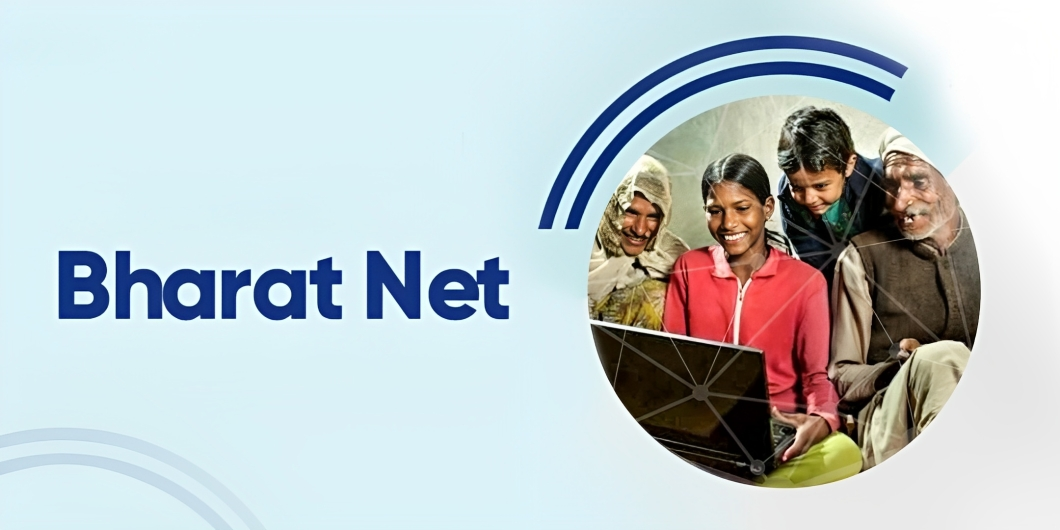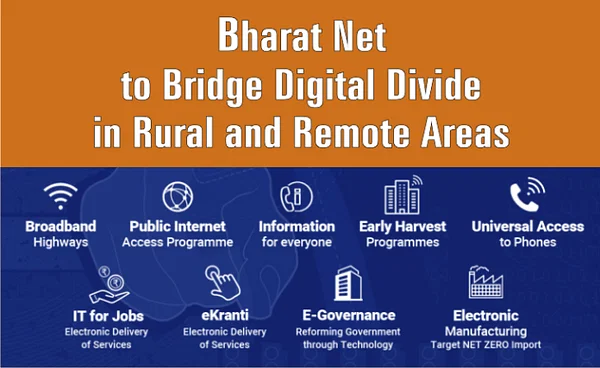
Copyright infringement not intended
Context: The Cabinet approved a fund of ₹1, 39,579 crore for the BharatNet project, reflecting a substantial investment to expand last-mile connectivity in rural India. As of now, approximately 1.94 lakh villages have already been connected under the project. The remaining villages are expected to be connected within the next 2.5 years.
Details
- BharatNet, formerly known as National Optical Fibre Network (NOFN), is an ambitious project initiated by the Indian Government in 2011 to provide broadband connectivity to all 250,000-gram panchayats, covering nearly 625,000 villages across the country. The project was implemented by Bharat Broadband Network, a Special Purpose Vehicle (SPV) incorporated in February 2012 under the Companies Act of 1956.
- In 2014, Government rebranded the NOFN as BharatNet and introduced several reforms to accelerate its progress.
- The project is being implemented by Bharat Broadband Network Limited (BBNL), a central public sector undertaking under the Ministry of Communications, in collaboration with other stakeholders such as BSNL, RailTel, Power Grid, state governments, local entrepreneurs and service providers.
Features of BharatNet
- BharatNet is the largest broadband connectivity program started by any government in the world. It plans to connect more than 6 lakh villages across India with an optical fibre cable (OFC) network.
- It provides a minimum of 100 Mbps speed to each gram panchayat (GP), the lowest administrative unit in rural India. The speed can be further upgraded to 1 Gbps as per the demand.
- It is based on three-tier network architecture: National, State, and local. The national level consists of a network of points of presence (PoPs) that are connected to the internet backbone. The state-level consists of state data centres (SDCs) that are connected to the PoPs. The local level consists of GPs that are connected to the SDCs through OFC.
- It is implemented through a public-private partnership (PPP) model in 16 states, where private concessionaires are selected through competitive bidding to create, upgrade, operate, maintain, and utilise the network. In the remaining states and union territories, BharatNet is implemented by BBNL or state-owned entities.
- It enables the delivery of various e-services to rural areas, such as e-education, e-health, e-commerce, e-governance, e-agriculture, etc. It also facilitates the development of local content and applications by rural entrepreneurs and innovators.

Significance of BharatNet
- BharatNet is a key component of the Digital India initiative, which aims to transform India into a knowledge-based economy and society. It bridges the digital divide between urban and rural areas and enhances the social and economic inclusion of rural citizens.
- It provides affordable and reliable broadband access to rural households, businesses, institutions, and government offices. It enables them to access information, opportunities, markets, and services that were previously inaccessible or costly.
- It creates a platform for innovation and entrepreneurship in rural areas. It supports the development of local solutions for local problems and fosters a culture of creativity and collaboration among rural communities.
- It generates employment and income opportunities for rural youth and women. It creates a demand for skilled manpower for network installation, operation, maintenance, and service delivery. It also empowers rural women to participate in economic activities and decision-making processes.
Steps Taken by Government for BharatNet
- PM-WANI (Prime Minister Wi-Fi Access Network Interface) provides public Wi-Fi hotspots in public places through a network of public data offices (PDOs).
- PMGDISHA (Pradhan Mantri Gramin Digital Saksharta Abhiyan) to make at least one person in every rural household digitally literate.
- CSC (Common Service Centre) provides a one-stop shop for various e-services such as banking, insurance, education, health, etc. through a network of village-level entrepreneurs (VLEs).
- UMANG (Unified Mobile Application for New-age Governance) provides a single platform for accessing various government services through mobile devices.
Challenges Faced by BharatNet
- Infrastructure: Laying optical fibre cables in remote and challenging terrains presents logistical difficulties. Terrain variations, rough landscapes, and geographical barriers can make the installation process time-consuming and expensive. Overcoming these challenges requires meticulous planning, coordination with local authorities, and innovative engineering solutions.
- Funding: Establishing a comprehensive optical fibre network across rural India demands substantial financial resources. Securing the necessary funding and budget allocation for the project can be a persistent challenge. Balancing budget priorities and finding sustainable funding sources are crucial to ensure the initiative's successful implementation.
- Maintenance and Sustainability: Maintaining and sustaining the network in rural areas pose ongoing challenges. Harsh environmental conditions, wear and tear, and technical glitches can affect network reliability. Ensuring a consistent power supply and trained personnel for maintenance and troubleshooting are essential to prevent service disruptions and maintain the network's long-term viability.
- Awareness and Adoption: Introducing digital services to populations that may be unfamiliar with technology requires efforts to raise awareness and promote adoption. Many rural residents may lack digital literacy and an understanding of the benefits of digital services. Community engagement, training programs, and outreach campaigns are vital to encourage people to embrace and effectively utilize the services offered through BharatNet.
Addressing these challenges is crucial to ensure the successful implementation and sustainability of BharatNe
Way Forward for BharatNet
- Strengthening coordination and monitoring: There is a need to strengthen the coordination and monitoring mechanism among various stakeholders involved in BharatNet, such as central and state governments, BBNL, private concessionaires, service providers, etc. A dedicated project management unit (PMU) can be set up to oversee the implementation and utilisation of BharatNet.
- Enhancing awareness and demand: There is a need to enhance the awareness and demand for BharatNet and e-services among rural users. This can be done by conducting awareness campaigns, training programs, demonstrations, etc. through various media and channels.
- Improving affordability and quality: There is a need to improve the affordability and quality of BharatNet and e-services for rural users. This can be done by reducing the tariffs, providing subsidies, incentives, or vouchers, ensuring adequate bandwidth, uptime, security, etc. The PM-WANI scheme can help in this regard by providing low-cost Wi-Fi access to rural users.
- Increasing relevance and innovation: There is a need to increase the relevance and innovation of BharatNet and e-services for rural users. This can be done by developing and offering local content and applications that cater to the needs and preferences of rural users. The UMANG app can help in this regard by providing a single platform for accessing various government services. The government can also encourage and support rural entrepreneurs and innovators to create solutions using BharatNet.

Conclusion
- BharatNet is a landmark project that has the potential to transform the lives of millions of rural Indians by providing them with high-speed broadband connectivity and access to various e-services. However, the project also faces several challenges that need to be addressed for its successful completion and utilisation. The government has taken several steps to overcome these challenges and accelerate the rollout of BharatNet across the country. Its success has the potential to reshape the landscape of rural India, fostering progress, prosperity, and equal access to the benefits of the digital revolution.
Must-Read Articles:
BharatNet PPP: https://www.iasgyan.in/daily-current-affairs/bharatnet-ppp
|
PRACTICE QUESTION
Q. Discuss the significance of the BharatNet project in the context of socio-economic development in India. How does the project impact various facets of society and the economy? Identify the challenges that the BharatNet project faces and propose potential strategies for overcoming these challenges and ensuring its successful implementation for the betterment of rural communities and the nation as a whole.
|
https://www.thehindubusinessline.com/info-tech/cabinet-approves-139-lakh-crore-for-bharatnet-project/article67161707.ece





